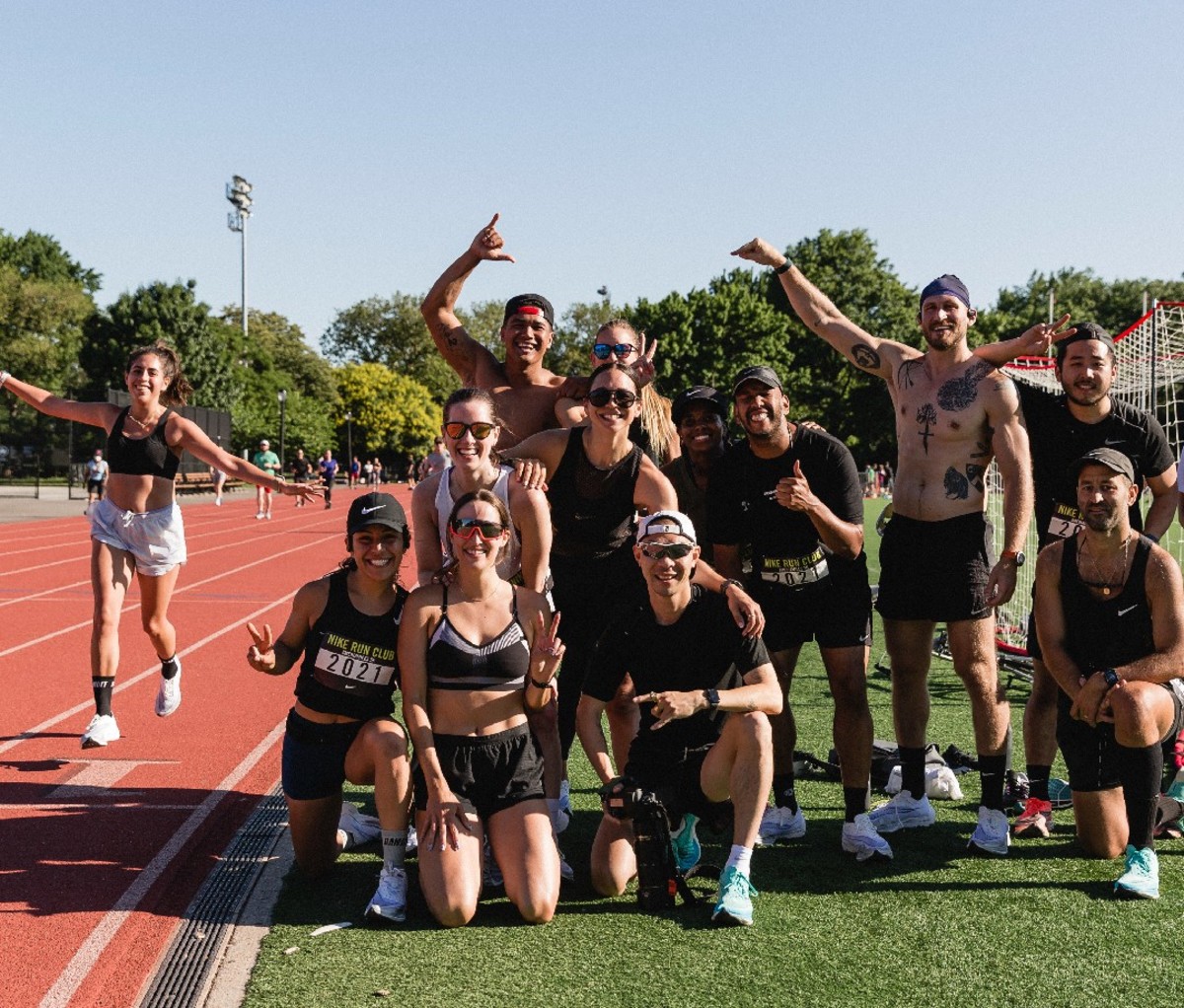Hi, is that you—a reluctant runner whose friends won’t shut up about running? Welcome to the reluctant runner’s guide.
Many people (read: runners) argue running is a sublime, exalted act that helps the mind and heart cope with life’s most vexing obstacles. Moving your body through space seems to stop time, quiet the mind, and return your baseline to something more primal. We were born to run. It’s a basic tenet of human evolution, and one of the few things that ties us inexorably to generations past. So why is the simple act of striding—the very act that set knuckle-dragging quadrupeds upright—so damn difficult to get into?
Our ancestors didn’t really have a choice in the matter. They were hauling ass to escape the snapping jaws of a saber-toothed tiger or to club a deer for dinner. But our modern-day motives are more complex. We run for sport, therapy, camaraderie, obligation. It stokes egos, quells anxieties, and dances the line between discipline and obsession.
If what I’m saying pulls on some thread of truth for you, here’s to more hard-charging miles, lazy loops, and lung-busting laps. For those of you who identify as non-runners but kinda sorta wanna try it out, heed our reluctant runner’s guide.
The Reluctant Runner’s Guide to Running

Reluctant Runner’s Guide Step 1: Ready or Not…Start Now
Show me a human who’s felt resolutely ready to take on a new challenge, and I’ll show you a liar. Starting something new is terrifying, but if you always waited to feel “ready,” you’d never heave your body out of bed.
If your mind is malleable or you’re at least mildly attracted to the idea of running, we’re in business. If your running history is defined by your timed high school mile, know this journey will be way more enjoyable, but fraught with ups and downs (bob and weave, baby, bob and weave).
Even though this is a reluctant runner’s guide, we can’t sugarcoat things: Some runs will pull you down into a deep, dark pit of despair. Embrace the suck. Marinate in it. Fighting a rip current typically spells disaster, but if you relax and succumb to the tide, you can ride the wave to shore. Half the battle (and art) of running is learning to stay the course. Endure the discomfort, because on the other side there’s an endorphin-fueled euphoria (the runner’s high can be elusive, but it’s not BS)—until, of course, you stumble into the next sticking point that threatens to sideline you. Get comfy in the hurt locker. Consider it a standing, sweaty confessional.
Whether you want to run a marathon, finish a charity 10K, or simply make running a ritual, you need to know you’ll be the middleman between the voice in your head and the devil on your shoulder. Shut them out, because without the distraction of a team or even equipment, you’re left to your own devices. Running is largely mental.

Reluctant Runner’s Guide Step 2: Suit up
Okay, we lied. You do need some equipment, but the barrier to entry here is small depending on how high-tech you wanna get. Finding the right running shoes is obviously key to running comfortably, but it’s not as simple as getting the right size and liking the colorway. You want us to tell you what to buy, we know. But what feels like lightning on our feet might spell torture for yours. This should also be obvious, but don’t cram your hooves into a narrow-fitting shoe just because it’s the new it pair.
Go to a running store and try on different brands and models so you can find the ones that work with your unique needs: foot width, sensitivities, join discomfort, underfoot feel. Yes, you can factor aesthetics in to some degree (cool running duds and kicks can get you more excited to train) and that first step out the door is often the hardest.
You also need to factor in function. You might want a pair of hard-wearing shoes for the brunt of your training and a pair of speedy racers for time trials, high-octane efforts, and race day. Let’s start with the former. Nike consistently cranks out out new running shoes using athlete feedback and NASA-level science, offering the largest range of styles than any other brand.
One of its most crowd-pleasing kicks is the Pegasus. The newest iteration, Nike Air Zoom Pegasus 38, is stable yet plush and offers a wider toe box. It’s a workhorse that’ll support you on your very first run. Another mainstay in the trainer lineup is Nike React Infinity Run, a shoe made to combat a big hurdle for beginners: injuries. In an independent study, the Infinity Run reduced injures in the knee, foot, shin, and/or calf by 52 percent compared to Nike’s Structure 22. React foam provides shock absorption and energy return to cushion impact forces, while lending a firm, springy feel underfoot. Cuts and grooves in the heel further absorb landing forces so they don’t ricochet up your legs, while tighter, shallower patterns by the toes boost responsiveness for smoother toe-off transitions.
As you progress, so should your running shoes. Nike Air Zoom Tempo NEXT% is where you’ll graduate. It’s got the specs of a race-day shoe—only pared down to be more suitable for everyday training. Expect a durable outsole and solid base for greater security during toe-off. Nike combined ZoomX Foam and React Foam in the heel for greater shock absorption, if you happen to be a heel striker, so you won’t feel the shoe tip or lose any momentum. (Don’t feel the need to over-correct your stride just because forefoot running is considered more efficient; if you’re not getting injured, run whichever way feels natural.) It’s got Air Zoom Pods for marked energy return and a softer carbon fiber plate that moderates the air bags and creates a smooth transition.
Take a look at run clubs and marathon finishers, and you’ll get a hint at what’s proven to be the fastest, most advanced running shoe to date: Nike Air Zoom Alphafly NEXT%. They’re not essential when you’re first getting started by any means, but if and when running takes off for you, these puppies will help you level up. They feel like rockets on your feet. When Eliud Kipchoge shattered records with his unofficial marathon time of 1:59:40 in 2019, he wore a prototype of the Alphafly NEXT%. The racing shoe boasts a snappy, full-length carbon-fiber plate and two Zoom Air pods in the forefoot for plenty of oomph with every stride. Your legs will feel less fatigued after longer, harder efforts.
Another stellar racing shoe if you want something more minimal is Nike ZoomX Vaporfly Next% 2. A carbon fiber plate runs the entire length of the midsole, in addition to the patented ZoomX foam to lend that torpedo-like sensation. The waterproof mesh upper was redesigned from the previous iteration to mold to your feet for greater containment and comfort.
To track your runs, invest in something like the Apple Watch Series 7, compatible with Nike Run Club, or Garmin’s GPS-enabled Forerunner series.

Reluctant Runner’s Guide Step 3: Find Your Why and Choose Joy Above all Else
Some purists get all high and mighty about running sans distractions, but we’re here to tell you to run happy. Before you head out, set an intention and do whatever’s necessary to support that.
If you need an amp-up, scour Spotify for a playlist that makes you feel like a dog off its leash charging with wild abandon. Want something light to accompany a neighborhood jog? Fire up Armchair Expert, Dax Shepard’s podcast. He might wax poetic about the proper butt-wiping technique with Jason Bateman (front to back or back to front?) one episode, then reminisce on Punk’d memories with Ashton Kutcher the next. And if you’ve got a long run on deck, ponder manhood and masculinity with Matthew McConaughey’s audiobook, Greenlights. Sometimes a distraction from the doldrums of running is exactly what you need to stay consistent—and that feels as great as any PR…green light.
If it’s guidance you seek, not entertainment, download the Nike Run Club app. Push any reservations toward guided runs away. There’s beauty in handing over the reins and letting someone tell you what to do. Nike’s band of coaches lends sage advice and just the right amount of inspiration to help you persevere without the overbearing rah-rah approach that can err on cheerleading. Some fan favorites include guided sessions like “Don’t Wanna Run Run,” “First Long Run,” and “Next Speed Run.”
You can also peruse training plans, like the 4-Week Beginner Training to get you up and running for the first time, or a 14-Week Half-Marathon plan.
Word to the wise: Don’t let ego dictate what a “good” run is. The “bad” runs, where you struggle to hit times or the intended mileage, are still notching progress in your belt. The weird thing about running is your best runs—where you feel strong and effortless—can come on days you feel sluggish and a little tight. Likewise, you might start out super motivated then lose steam halfway. Don’t fixate on the end goal. Appreciate and celebrate checkpoints along the way.
Running may reward those who race with logic-shunting guts à la Steve Prefontaine (above), a legendary long-distance runner, but train with patience and humility. Don’t rush the process. Building endurance takes time. To get fast you have to go slow. And, unless you enjoy physical therapy, you need to commit to training holistically: foam rolling, dynamic warmups, cooldowns, strength training, proper fuel and hydration, the occasional deep-tissue massage, and rest days.
One more nugget to mull over: You have no idea what your limits are. Take pleasure in knowing your potential is untapped and ripe for exploring.

Reluctant Runner’s Guide Step 4: Chase Strangers Until You’re Running With Friends
Once you build up some endurance and speed, consider seeking out a local run club. It’s one of the best ways to stay accountable and jazzed about lacing up each week.
Run clubs are more popular in metropolitan areas, but search Road Runners Club of America, ask your local running store, or even stop to talk to groups at a track or out together on road runs. It’s hard to communicate how valuable the relationships are, but it reshapes the way you look at training. Working in a group changes an “I have to” to an “I get to.” You know what they say about misery loving company? A solo sufferfest will always be trumped by a grueling group workout.
When you’re doubting your abilities, you can turn to teammates to keep you motivated, push you harder, and affirm you’re exactly where you’re supposed to be.
After high school and college, races become more of an individual competition. You’re trying to beat your own 5K or marathon time, not looking at the person next to you as a threat.
When there’s nothing at stake, you’ve got everything to gain.
Reluctant Runner’s Guide Step 5: Rinse and Repeat
Now that you have the tools of the trade and a game plan underway, enjoy the ride. Whether or not you sign up for a race or clock a “fast” time, you’re part of the greatest community. You’re a runner.
All that’s left to do is put one foot in front of the other.
For access to exclusive gear videos, celebrity interviews, and more, subscribe on YouTube!